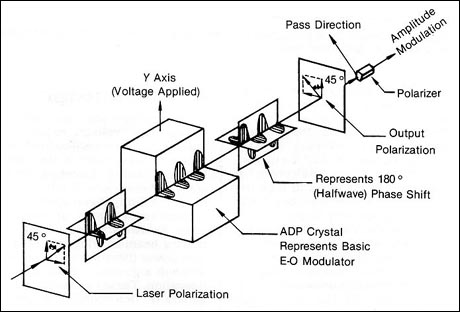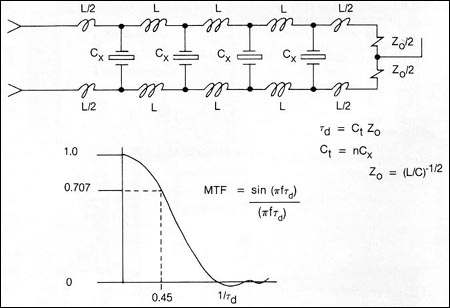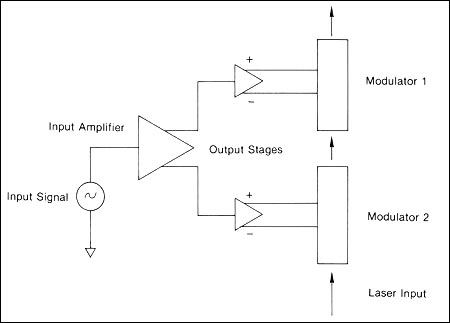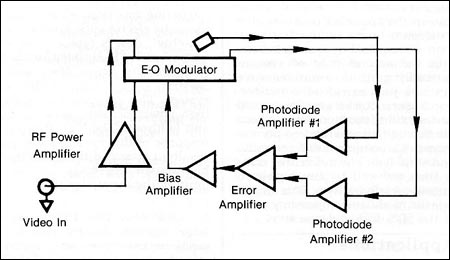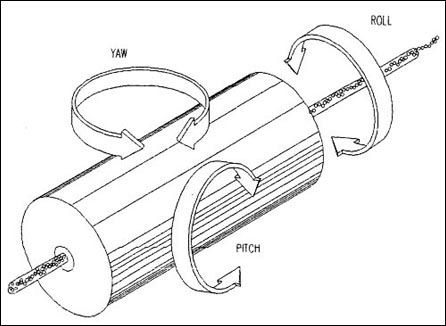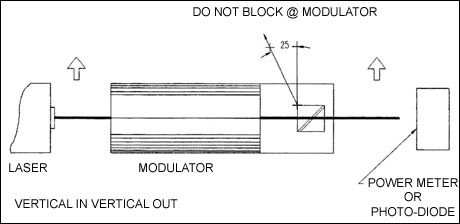Applications
Electro-Optic Modulation: Systems and Applications
Demands for Wider-Band Beam Modulation Challenge System Designers by Robert F. Enscoe and Richard J. Kocka
The laser, when coupled with a wideband modulation system, has many applications in data recording. As data recording has progressed, demands for wider recording bandwidths have marked the design of modulators. In this article, we’ll consider the design and application of transverse-filed electro-optic modulators using the Pockels effect. This effect produces a refractive index change when an electric field is applied to specific classes of crystals.
The electroded crystal may be considered to be a voltage-variable waveplate (Figure1.) When a voltage is applied, the polarization of the light exiting the crystal changes. This variation in polarization results in intensity modulation downstream from the output polarizer.
The ideal electro-optic material possesses all of the following properties:
- large change in refractive index per volt.
- high optical quality and transmission* low dielectric constant (low capacitance).
- low dielectric loss tangent (no dielectric heating due to a high-frequency electric field)
- no distortions in modulators output from piezoelectric resonances.
Figure 1. Retardation of laser polarization while a laserbeam passes through an ADP crystal. The output polarizer converts the phase shift into an amplitude modulation.
Unfortunately, all crystals that exhibit the electro-optic effect are also piezoelectric. At low frequencies, one part of the total measured response results from a refractive index change produced by the applied electric field. Another portion is produced by piezoelectric strains. The piezoelectric strain contribution can be minimized by proper choice of material and orientation. Of all the electro-optic materials, the optimum choice in this respect is ADP {NH4H2PO4} in the 45° Y-cut configuration. It yields a difference between high frequency and low frequency response of less than 0.4%. This compares very favorably with differences of 10 to 20% in other materials, which have severe amplitude and phase distortion near the mechanical resonance frequency. This crystal orientation (45° Y-cut) utilizes the R41 electro-optic coefficient, which, in addition to resonance-free response, has a low electro-optic coefficient sensitivity versus temperature.
Modulator Design
The aperture size and halfwave voltage (the voltage required to change the transmission from minimum to maximum) of the modulator are fixed by laserbeam dimensions and realizable levels of driver output. A 3-millimeter aperture will accommodate nearly all commercially available lasers without requiring beam-forming optics. Available power transistors will handle a 100-volt signal in a push-pull configuration. These two requirements generally determine the crystal dimensions.
The 45° Y-cut ADP crystal exhibits double refraction as well as birefringence. The first pair of crystals (Figure 2) are aligned to cancel out the double refraction. The second aligned pair is rotated 90° with respect to the first pair to cancel out the natural birefringence.
The operational stability of the modulator depends upon the four crystals being exactly aligned and of exactly the same dimensions. To insure that these requirements are satisfied, all the crystals used in the modulator are cut from the same crystal boule and are polished together to keep the lengths the same.
Figure 2. Typical transverse-field elctro-optic modulator. The first two crystals cancel double refraction and the second pair cancel the natural birefringence.
Drive Amplifier Considerations
Once the modulator’s electrical characteristics have been defined, various design approaches may be evaluated for the optimum amplifier configuration. Let us assume the following the following typical modulator electrical drive requirements: • laser operating wavelength is 514 nanometers, • modulator capacitance is 180 picofarads, and • halfwave voltage is 97 V at 514 nm.
Bandwidth considerations will now determine the configuration of both the driver and modulator. If system bandwidth is the range of DC to 10 megahertz, the modulator may be driven as a lumped capacitor. A push-pull common-emitter stage with a balanced output impedance of 100 ohms will perform quite nicely throughout this range. Some shunt peaking in the amplifier output will deliver detected rise times of 35 ns with less than 5% overshoot. Figure 3 depicts the modulator as a single 180-pF capacitor. Detected response is close too 10 MHz with short interconnecting cables between modulator and driver.
Figure 3. Equivalent cicuit for low-frequency modulator (<10MHz). The crystal is modeled as a single, lumped 180-pF load.
If bandwidth requirements exceed 10 MHz, the most efficient method of obtaining broader bandwidths is to configure the modulator as a balanced transmission line. In figure 4 we have incorporated the individual crystals into a balanced line. The total capacitance remains unchanged, but, depending on how the crystals are electroded, the electrical cutoff frequency may be extended dramatically, yielding low voltage-standing- wave-ratios to the driving electronics. The bandwidth of this configuration follows a (sin x/x) response, with the first zero crossing at
Figure 4. Equivalent circuit for high-frequency modulator (> 10 Mhz), where the modulator is configured as a balanced transmission line.
For a modulator with the same total capacitance and a driver with equal output impedance, the bandwidth is improved by a factor of 2.5 over the simpler, lumped, single 180-pF case. This improvement comes at no increase in output power of the drive electronics. To extend the bandwidth past 25 MHz, the intrinsic propagation delay of the balanced line must be reduced. This may be accomplished either by reducing the total capacitance of the modulator (i.e., using a smaller optical aperture) or by lowering the characteristic impedance oaf the balanced line.
One 50-Mhz system uses an optical modulator with a 50-ohm characteristic impedance, thus reducing the delay to 9 ns and doubling the useable bandwidth of the modulator. At this point, the drive electronics’ power-handling capability must be doubled. Operating from DC 50 MHz requires a much-broader-bandwidth output stage in the driver. A cascade-connected, ground-base output stage is an excellent choice for broadband operation, because it removes any Miller capacitance at its input, thus reducing the reactive component of the input impedance to the stage. The large-geometry output transistors required for high-current operation have intrinsically high output capacitance (Cob) which cannot be tuned out as the stage response extends down to DC.
The common-base design increases the output break frequency of the amplifier, as the typical Rbb and associated external base impedance are negligible. Common-base operation is potentially the most unstable amplifier connection, since the device exhibits gain out to f. This makes small parasitic strays dominant at frequencies where the device still has forward gain. For this reason, the designer must pay close attention the electrical performance of the transmission line within the modulator.
Doubling the bandwidth again, to 100 MHz, presents a far more complex problem than going from 25 to 50 MHz. Extending useable response from DC to 100 MHz requires that the propagation delay of the modulator again be cut in half. To cut the impedance to 25 ohms would mean that the peak current in the output stage would be greater than 3.6 amps. Devices with this current-handling capability have very large output capacitance and would, in effect, limit the response of the driver to less than the required system bandwidth. Paralleling smaller-geometry devices in the output would also parallel output capacitance, yielding the same results as the larger output transistor. Reducing the total modulator capacitance would cause a dramatic reduction in the useable optical aperture, thus precluding large-frame ion lasers without beam-forming optics.
One viable alternative is to section the modulator in two pieces, cutting the electrical delay of the modulator in half, and then driving the modulator section electrically in parallel, optically in series. Each modulator section would then rotate the plane of polarization 45°; when combined, they would deliver a full 90° rotation. This approach (Figure 5) would maintain a 50-ohm characteristic impedance for each section.
Figure 5. Sectioning a modulator into two pieces, with the electrical drive in parallel and the optical drive in series, is one means of extending bandwidth to 100 MHz without enduring difficult electrical-drive conditions.
Maintaining a 50-ohm characteristic impedance keeps the interconnecting balance cable at a commercially available value and also removes the difficult power-handling requirements that a 25-ohm structure would have required. The amplifier is capable of putting out more than 40 watts of RF power from DC to 100 MHz. All of the transmitted RF, after propagating down the electro-optic modulator, is absorbed by high-power thick- film resistors, which terminate the line in the proper characteristic impedance. No electrical power is absorbed in the modulator head, as all the elements are reactive.
Large-signal, DC-coupled linear amplifiers have to deal with very large dynamic power changes within the active devices. This device dissipation change versus operating point shows up in the output as a signature or “thermal tail”, which will effect the overall repeatability of the input/output transfer function. Good repeatability is essential in analog imaging recorders for tight correlation between the video input signal and resultant exposure level. Thermal time constants of small-geometry devices can be in the 2 to 3-microsecond range, well within the more dominant, low frequency imaging detail. The only practical way to minimize this effect is to make the quiescent amplifier current large with respect to the current signal, thus making the particular stage dissipation remain fairly constant. Closed-loop feedback is not practical because the inherent propagation delay through the amplifier is typically of the order of tens of nanoseconds, thus limiting the loop bandwidth to a few megahertz.
Modulator Bias Control
Since transverse-field modulators are path-length-dependent devices, the alignment of the laser to the crystal and temperature gradients affect the modulator’s quiescent operating point. For this reason, a DC “biasing” voltage is applied to the modulator to properly position the quiescent operating point on the transfer function. This voltage is typically controlled manually by a high-resolution potentiometer our automatically by a nigh-gain feedback loop.
Typically, two different types of automatic servo systems can be used, depending on the application. For scanning systems, where a “dead time” (retrace) is available, a sampled loop is often used (Figure 6). During the dead time, a signal is applied to the system at J2 that instructs the loop to start operation. A signal is generated by the clock, amplified by the RF power amplifier, and sent to the modulator. A photodetector examines the resultant modulation, while a sample -and-hold extracts amplitude phase information. The resultant error signal (if any) is amplified and applied to the modulator through the bias amplifier to reduce the operating point error. The sampled system can set the operating point at either minimum or maximum transmission, as required by system format.
Figure 6. Servo control technique for a rastered scanning system takes advantage of the “dead time” in the flyback. The operating point can be either the 0%- or 100%-transmission level.
In the second type of system, generally used in continuous wave systems such as videodisk mastering (Figure 7), the average optical power exiting the modulator in both the throughput and rejected ports is measured, compared differentially, and amplified. The differential error is then reduced by the high-gain negative-feedback loop. This format sets the modulator’s operating point at the 50% transmission level.
Figure 7. Servo control for a cw operating system provides continuous control of the output signal. The operating point is at the 50%-transmission level.
| ApplicationsElectro-optic modulators and modulation systems have been available for many years. They have found use in many applications requiring amplitude or phase modulation of cw or pulsed lasers. The offer speed and optical efficiency without the need for beam- forming optics. Some of the more common applications include the following:Imaging and Data Recorders.High-speed recording of analog imagery or digital data on photographic film has both military and commercial applications. As the state of the art in laserbeam recorders advances, the need for broader modulation bandwidth and higher laser throughputs increases. Electro-optic modulators can deliver this performance without compromising overall beam geometry.Disk RecordersVideodisk mastering has been entirely dominated by electro-optic systems. the “mother” disk is typically written with a 7-MHz FM-encoded format by a largeframe argon laser and a 50-MHz electro-optic modulation system. This combination delivers high power density and 7-ns rise and falltimes. the high frequency response of this system allows the resultant recorded pit geometry too be shaped correctly by bandlimiting the input signal.Digital RecordingThe extremely large storage density capability, rapid access time, and archival storage properties of optical media make it attractive over traditional magnetic formats. Real- time single-track data recording of over 100 MHz is attainable with the laser-based system. Other applications include seismic recording for oil well exploration: color separation and halftone screen generation for reprographics: and recorders for the entertainment industry that convert either real-time television camera or videotape recorder output to 35- or 70-mm film. This allows electronic “special effects” and editing to be done before the picture is recorded.Electro-optic modulators also lend themselves to many research and development applications such as polarization rotators in high-speed ellipsometry, broadband optical feedback loops for plasma noise reduction of argon and dye lasers used in Raman spectroscopy, and high-speed pulse from a modelocked train. Electro-optic modulation systems offer the system designer very broad modulation bandwidth along with high optical efficiency. No dedicated beam-forming optics are required, and the interface requirements placed on the host system are minimal. |
Modulator Alignment Procedure I. All products described here are “transverse field type” Pokels cells.
They:a) are multi-crystal designs, typically 2 or 4 crystal configurations.b) Are compensated to minimize the natural net birefringence.c) Require DC offset voltage to set the quiescent operating point.d) Are supplied with an output polarizer, pre-aligned to the crystal axis.e) Require the input laser to be polarized; if not, you must use an auxiliary polarizer at the input.f) Are filled with index matching fluid. Window assemblies should not be removed.
II. The modulator materials are:
a) ADP; for the 370, 380, and 390 series.b) KD*P; for the 350 series.c) Lithium Niobate or Lithium Tantalate for the 360 series.
III. Alignment
1. A suitable modulator support must be provided so that roll, pitch and yaw adjustments can be performed. (See Figure 1)
Figure 1.
2. A DC power supply is required, if you have a Conoptics driver, one is included with it.
3. Align the modulator such that the beam enters and exits without any beam distortion. This should be at low power, <200mw. If you can not lower the laser power to this level, use an auxiliary polarizer at the input to lower the power.
4. Rotate the cell about its axis too align the polarization to the crystal axis (see Figure 2.)
Figure 2.
Please note that if you’ve used an auxiliary polarizer at the input for power attenuation, it will have to be removed for this step. If your laser polarization is vertical, then the rejected component will be directed to the ceiling or table top. Do not block the rejected component at the modulator. If you want the plane of polarization horizontal (vertical in) then the rejected component will be in a plane parallel to the table top. (See Figure 3)
Figure 3.
5. Fine polarization alignment. Align the power meter or photo-diode to accept the beam exiting the modulator. For parallel operation (vertical in-vertical out), adjust the bias voltage and the rotation of the cell for a minimum; for crossed operation, adjust the bias voltage and rotation for a maximum.
6. Fine pitch and yaw adjustments. Adjust the voltage for a maximum and note the extinction ratio (max/min). Adjust the voltage for a minimum; adjust the cell in pitch and yaw, slightly, while observing the minimum (you will have to re-adjust the voltage), to improve the minimum. Re-check the maximum to be sure that you have not reduced it.


